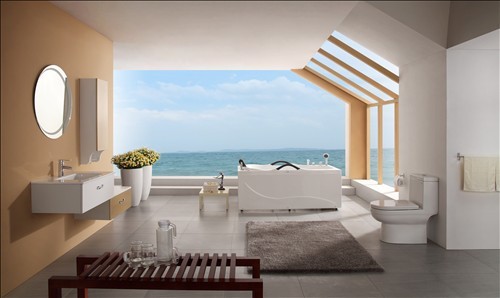
When it comes to modern bathroom renovations, purchasing ceramic products is almost inevitable. However, many consumers lack the fundamental knowledge needed to make informed choices. Instead of relying on technical specifications, they often base their decisions solely on appearance and price. This can lead to serious issues down the line, such as poor cleanliness, ineffective odor control, cracking of ceramic surfaces, and yellowing over time—potentially even affecting the health of your family.
Water Seal
â—† Water seal height: The vertical distance from the water surface in the trap to the highest point of the inlet should be at least 50mm for all toilet bowls, urinals, and squat toilets with integral traps.
◆ Water seal area: The surface area of the installed water seal on a horizontal surface should not be less than 100mm × 85mm.
â—† Water seal function: It isolates odors, maintains sufficient pressure to assist in flushing, helps dilute waste, and prevents adhesion.
Drainage Distance
â—† Toilet drainage systems are typically categorized into lower drainage, horizontal drainage, rear drainage, and wall-mounted drainage. Each type has its own advantages and installation requirements.
Water Absorption
â—† Water absorption refers to the percentage of weight increase of a ceramic piece after being submerged in water under specific temperature and time conditions.
â—† The higher the firing temperature, the lower the water absorption rate.
â—† A lower water absorption rate means less dirt retention, making the product easier to clean.
â—† It also reduces moisture absorption, which is better for user health and long-term durability.
Burning Temperature
â—† This is the maximum temperature reached during high-temperature firing to meet quality standards.
◆ For four-dimensional ceramic sanitary ware, the firing temperature can reach up to 1280°C. This results in stronger products that are less likely to crack over time, along with low water absorption, which promotes better hygiene and safety.
Dilution Rate
◆ It measures the product’s ability to replace wastewater effectively.
â—† If the dilution rate is insufficient, it may result in poor flushing performance and unsanitary conditions.
Flushing Methods
â—† Siphon-type toilet:
This type of toilet uses negative siphon pressure created by the flow of water in the drain pipe to suction out waste. The design of the drainage pipe is critical—smaller diameters create better siphoning but are more prone to clogging, while larger diameters may reduce siphon efficiency, affecting the overall flushing performance. Siphonic toilets also require higher water velocity and pressure during use.
With the advancement of Gemmers’ large-diameter technology, siphon-type toilets have become increasingly popular in the domestic market, featuring a 51mm diameter pipe that ensures excellent flushing performance.
â—† Direct flush toilet:
This method relies on concentrated water pressure to flush away waste. It requires a drainage pipe with a diameter larger than 70mm, which makes it less likely to clog. Its main advantage is the larger drain pipe size, which ensures smooth operation and minimal blockage risks.
Adjustable Lamp,Solar Wall Sconce,Solar Sconce Lights,Solar Powered Wall Sconce
Ningbo Royalux Lighting Co., Ltd. , https://www.royaluxlite.com
